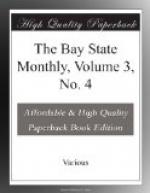* * * * *
The proceedings of the Bostonian Society at its annual meeting in January, 1885, have just been published in pamphlet form. It embraces much valuable data. The illustrations consist of a fine heliotype view of the Old State House, from the east end, the home of the Society; and a copy of its well-devised seal, in the heraldic coloring. The experiment of a cheap pamphlet giving a summary historical sketch of the Old State House has been successful, and another similar publication is contemplated.
* * * * *
Rebecca Nourse, who was the first person hanged as a witch at Salem, in 1692, notwithstanding her repeated affirmation of her innocence, has just had a monument erected by her descendants. On one side of it is the legend concerning her, and on the other these lines of the poet Whittier:—
“O Christian martyr, who for truth
could die,
When all about thee owned
the hideous lie.
The world, redeemed from superstition’s
sway,
Is breathing freer for thy
sake to-day.”
* * * * *
In his address at the unveiling of Ward’s statue of “The Pilgrim,” erected in Central Park, New York, by the New England Society in the city of New York, Mr. George William Curtis said:—
“Holding that the true rule of religious faith and worship was written in the Bible, and that every man must read and judge for himself, the Puritan conceived the church as a body of independent seekers and interpreters of the truth, dispensing with priests and priestly orders and functions; organizing itself and calling no man master.”
* * * * *
AMONG THE BOOKS.
There have been earlier biographies of John Brown, the martyr of Virginia; but by none of them have his character and acts been told so fully and judged so fairly as now by Mr. Sanborn.[6] His later biographer, furthermore, has had access to all the papers and letters, that remain, bearing on Brown’s life, and of these he has made the very best possible use. In the arrangement of the materials at his command, Mr. Sanborn has shown admirable taste and judgment, and, without seeming to be a eulogist, has contented himself with allowing his hero to speak for himself, or rather to plead his own case. Viewing the case as a whole, with its back-ground of antecedent history, no fair-minded person can longer regard John Brown as either an adventurer or as a madman. He was by nature, however, enthusiastic; he believed that he had a mission in this world to fulfil, and that, the freedom of the slaves. This mission he cherished uppermost in his mind, for its accomplishment he labored and suffered incessantly, and for it he died. He lacked one quality,—discretion. His pioneer life in New York, his thrilling adventures in Kansas, where he fought slavery so fiercely that




